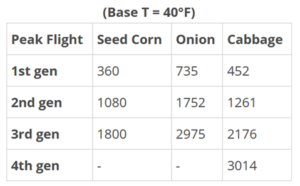Hi all,
The rainy and cool weather continues to dominate throughout the region and has shaped pest populations here in Vermont. Many pests are persisting that, in previous years, may have waned in their damage, while others seem to be arriving later than usual.
Some of the more persistent pests this season are the root maggots, particularly seed corn maggot, cabbage root maggot, and onion maggot. These pests are currently being reported and/or observed on various farms and seem to be causing significant damage. Seed corn maggot is the earliest to emerge in the season, while onion maggot is the latest (see degree day benchmarks below. According to degree-day models, onion maggot is currently at 50% peak emergence or less in Vermont. Fortunately, with the upcoming forecast of rising temperatures, we’re hopeful we’ll begin to transition out of this high-pressure period. Typically, warmer and drier soils reduce the viability of maggot eggs.
Degree-Day Thresholds for Maggot Pests

Similar to the root maggots, slugs and isopods (a.k.a. rollie pollies) are also thriving in these cool, wet conditions. These non-insect pests require very high humidity to survive—which is nearly impossible to avoid right now. Sluggo is a highly effective organic option for slug control, and some growers report that it can help reduce isopod pressure as well.
We’ve received several questions about allium pests over the past week.
Allium Leaf Miner (ALM): This pest hasn’t historically been a major issue in Vermont, as it typically emerges in late April and enters its “summer hibernation” by early June. Since the fly spends most of the summer (June–September) in the soil as a pupa, it usually isn’t a major concern for onion growers. However, it can affect scallions or leeks later in the season. A telltale sign of ALM is a line of small white dots on the foliage.
Leek Moth: As mentioned last week, the leek moth flight appears to be ending, meaning most of the population is likely in the egg stage on alliums. We’ll be actively scouting garlic over the next couple of weeks for signs of caterpillar feeding and will report as soon as we see any. Typically, leek moth does not cause serious yield losses in onions or garlic, but it can be problematic if brought into storage on the foliage. Topping onions or garlic is a relatively effective, low-cost method to reduce their impact. Leeks, however, can be more significantly affected.
Finally, with potato planting season underway for many farmers, we wanted to share some recent research findings on Colorado potato beetle. In our delayed planting trials, we observed increased yields and reduced damage with plantings in late June to early July. The graph below shows results from a fully replicated trial at the UVM research farm. On-farm trials are currently underway, and we’re always looking for volunteers—or hearing from folks already trying some version of “delayed planting.”

Be on the lookout of the following pests:
Some pests that are being reported in more southernly and warmer regions are:
- Onion thrips are being found in MA, and a few farms in the warmer areas of VT
- Beet and Spinach Leaf miners are around in MA
- Cucumber beetles are in high tunnels and likely will be moving around quite a bit this week.
You can now access our website via this link: https://go.uvm.edu/vpart. Also, you can now directly submit any pest sightings or questions to our team. Direct emails from the VVBGA listserve are acceptable as well. As always, you can access our pest reports on our website or by directly navigating to the scouting blog.
Feel free to reach out to us if you have any questions.
| Pest | Crop | Observations |
| Cabbage root maggot: | Brassicas | We are seeing damage in various early season brassicas including radishes. We are fully in the first generation of cabbage maggot. |
| Onion maggot. | Alliums | We have gotten reports that onion maggots are being found in some onion plantings in Chittenden Coutnty |
| Leek Moth | Onions/Garlic | First flight is waning, so much of the populations are likely in the egg stage. |
| Flea Beetle | Arugula, kale, broccoli | Beetles are being found in high numbers in many brassica crops. Row covers can be an effective strategy for protecting vulnerable brassica seedlings. |
| Cutworms: | Various crops | Cutworms are causing a lot of trouble in high tunnels and in the field. We’ve seen several large outbreaks in gardens around Burlington s |